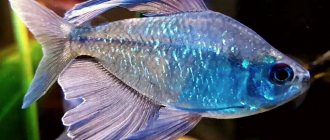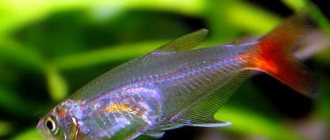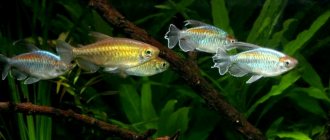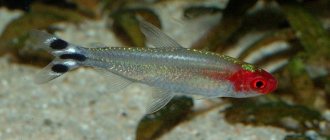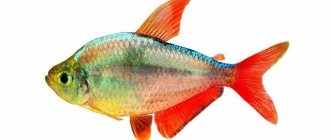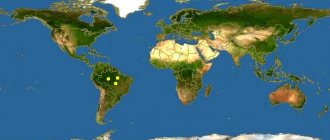Amanda's tetra (Hyphessobrycon amandae) GERY & UJ, 1987.
A tiny, graceful fish that can decorate any aquarium. It was opened not so long ago in 1987.
Synonyms
English: Fire dwarf tetra, Red tetra, Ember tetra
Etymology
Hyphessobrycon: From Ancient Greek (hyphesson) meaning "smaller in stature", used as a prefix in this case, plus the generic name Brycon. amandae: named after the mother of Heiko Bleher, who first described it.
Family: Characinaceae Genus: Hifessobrykon
Habitat
Originates from South America from the Tocantins River basin and its main tributary Araguaia - the central regions of Brazil (the states of Tocantins, Mato Grosso and Pará).
Inhabits small tributaries, small streams, rivers, and oxbow lakes. The natural habitat usually contains soft, slightly acidic water with a sandy substrate covered with a layer of fallen leaves and twigs. Brief information:
- Aquarium volume - from 40 liters.
- Temperature - 20–28°C
- pH value – 5.0–7.0
- Water hardness - 1–10 dGH
- Substrate type - any dark
- Lighting - dim
- Brackish water - no
- Water movement is weak
- The size of the fish is up to 2 cm.
- Food - any food of suitable size
- Temperament - peaceful
- Keeping in a group of 8–10 individuals
Behavior and Compatibility
Feels confident in the company of at least 8-10 relatives, if more, then even better.
It has a peaceful character, so it can be kept with the same calm species: pygmy corydoras, otocinclus, nanostomus, rasboras, zebrafish, small iris and shrimp; are ideal neighbors for Apistograms and other dwarf cichlids. Neighborhood with large or aggressive fish is contraindicated.
A schooling species, so buy as many as possible from 10 or more, since with this number the fish are more active and less timid, more often visible and have better coloring, and exhibit more natural behavior.
Maintenance and care, arrangement of the aquarium
The optimal aquarium sizes start from 40 liters. The design uses a large number of aquatic plants, including floating ones, and dark soil. In such a contrasting environment, the fish will look most impressive. A layer of leaves of some trees will not be superfluous; during the process of decomposition, they will give the water a chemical composition similar to that of natural reservoirs, and will also serve as a secondary source of food for the fry—slipper ciliates can reproduce among the leaves. Keeping Amanda's tetra is quite simple and will require the aquarist to carry out several standard aquarium maintenance procedures. The minimum set of actions is a weekly replacement of part of the water with fresh water, regular removal of organic waste (remains of food, excrement), maintenance of equipment, etc. Filtration should not be strong; excessive flow has a negative effect on the fish. Sometimes a simple airlift filter with a sponge is enough.
Feeding
Since these are very small fish, you need to choose food specifically for small fish. Dry high-quality flakes and pellets are suitable; it is better if the food sinks - tetras love
catch food in the water or pick it up from the bottom. Small frozen and live foods, such as brine shrimp, cyclops, and small bloodworms, are also suitable for feeding.
It is better to feed several times a day in small portions, which should be eaten in a matter of minutes (up to 3 minutes or less). This will keep the water clean and prevent waste from accumulating in the water.
Breeding/reproduction
The fish are easy to breed, but preserving the fry can cause certain difficulties, since tetras do not show parental care for the offspring and will certainly eat them if necessary. In addition, the emerging fry are very small and require microscopic food, such as ciliates. With the onset of the mating season, females scatter eggs among plants, which are fertilized by several males. If breeding is planned, then the eggs should be carefully transferred to a separate tank filled with water from the main aquarium. It is equipped with an airlift filter and a heater. No lighting source is required; light coming from outside will be enough.
Nutrition
In nature it feeds on small invertebrates and other zooplankton.
They are unpretentious and accept all types of food: live and frozen brine shrimp, cyclops, daphnia, moina, flake mixtures, granules.
When compiling a diet, it is important to make it as varied as possible, since this directly affects the brightness of the color and do not forget that this tetra has a very small mouth and, if necessary, the food must be crushed.
Fish diseases
No diseases specific to this particular type of fish were noted. When kept in suitable conditions (high water quality, balanced diet, non-conflicting neighbors, etc.), health problems are not observed. The most common cause of disease is deteriorating conditions leading to suppressed immunity, which makes fish susceptible to infections that are invariably present in the environment. When the first signs of illness are detected (lethargy, exhaustion, refusal to eat, drooping fins, etc.), it is necessary to immediately check the basic parameters of the water. Often, restoring acceptable living conditions promotes spontaneous recovery, but if the fish is too weak or has obvious injuries, drug treatment will be required. Read more about symptoms and treatment methods in the section “Diseases of aquarium fish”.
Description
The body is elongated and slightly flattened on the sides.
They are painted in a rich reddish-orange color, but its intensity largely depends on the conditions of detention. The rim of the eyes is golden, the unpaired fins are reddish. There are light gray or cream spots at the top of the dorsal fin and on the forked tail.
Size:
The length usually does not exceed 15 - 20 mm, but sometimes individuals up to 30 mm are found.
Tetra amanda or Fire tetra (Hyphessobrycon amandae)
The Amanda tetra or Fire tetra (Hyphessobrycon amandae) is the smallest known species of tetra in the aqua hobby. Recently, Hyphessobrycon amandae has become much more accessible to aquarists. It was discovered in 1986 by Heiko Bleher, made a description of the species and named it, as a discoverer, in honor of his mother, researcher Amanda Bleher.
In a well-kept aquarium, in their own flock or in the company of suitable neighbors, active and bright nano-tetras will become a real pearl of the collection. Under natural conditions, it can be found in Brazil in forest streams and tributaries of the Amazon River.
At the bottom of these waters you can often see fallen branches and leaves, which, when decomposed, release tannins and other chemicals, causing the water in these tributaries and streams to turn brown. Luxurious forest and dense vegetation create constant shade in these areas, where the water has a neutral or slightly acidic, soft environment.
For Tetra Amanda or Fire Tetra, the design of the aquarium is not so important, although in aquariums with a dark bottom the fish looks much more attractive. Therefore, Aquascape or Nature Aquarium would be an excellent choice for Hyphessobrycon amandae. Fish feel more protected among floating plants that create shaded areas. In such conditions, the shiny, red-orange color appears more.
Since fish live in slow waters and are not able to fight fast currents, it is necessary that the filtration in the aquarium is not strong. The best option for Amanda's tetra would be a sandy, soft substrate with a few driftwood and branches positioned to create plenty of shade.
If you find it difficult to find suitable driftwood, an oak or beech branch of the desired shape will do, just first you need to thoroughly dry it and clear it of bark.
Young males and females do not differ in color. But adult females have a more rounded and swollen body shape than males. They can also be distinguished by the shape of their swim bladder, which is clearly visible through their almost transparent body. In males the swim bladder is small and has an irregular pointed shape, while in females the swim bladder is simply large.
Tetra Amanda is an omnivorous species and will eat anything you can offer. The fish has a small mouth, so the first requirement for food is that it should be small in size. Small, frozen and live foods are great, as well as a mixture of dry granules and flakes. If you need to improve coloration and influence development, you can take certain diets.
The fire tetra is a fairly peaceful species that will not compete with both larger neighbors and much more active ones. The tiny adult Hyphessobrycon amandae will not harm anyone: newborn neocaridine shrimp, tigers, crystals. Ideally, they can be kept together with other calm species from Southeast Asia and South America, such as nano Corydoras and Otocinclus, Apistogramma cyclids, Nanastomus, Boraras. They also feel great in association with small Barbs and Rainbows.
The recommended number of fish in a school is at least 7, and preferably 10-15 or more. Optimal maintenance conditions: t 22−27°C, dH 8−16°, pH 6.8−7 , filtration, aeration, weekly water changes up to 25%.
Amanda tetras always swim in schools, they keep a school well and it is almost impossible to disperse them; they feel much more comfortable in the company of others like themselves. Fire tetras prefer mainly the lower half of the aquarium and swim a lot if they live in the company of other species, and if there is a flock of only tetras in the aquarium, then the flock spends most of the time in one place. This type of tetra will be an excellent ringleader and neighbor for the shy Microrasbora Galaxy.
Reproduction
This species is quite easy to breed for experienced aquarists. By the time of spawning, males become much more colorful and graceful, and females reach 2 cm and have a rounded abdomen. They need to be given a separate space to get more fry.
An aquarium with dimensions of 30x20x20 may well do. It is better that it is shaded and contains thin-leaved plants such as Java moss or other spawning substrate. Suitable water is soft and acidic with a pH of 5−7 GH 1−5 and a temperature of 27−29 degrees C. Osmotic water and filtration are extremely useful for dilution. A small airlift filter is best.
The spawning of the Fire Tetra is a beautiful and very interesting spectacle. Fish can spawn in pairs. But it is better to provide them with a separate aquarium. When the males show the brightest saturated colors, and the females are rounded and have a large number of eggs, you need to select the brightest males and the roundest females and place them in the aquarium for spawning. It's better to do this in the evening.
Spawning should take place the next morning. Adult fish can eat eggs at any time, so they should be removed immediately after spawning. The eggs are incubated for 24–36 hours. Free swimming of the fry begins after 3-4 days.

